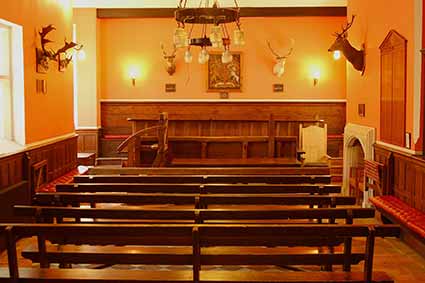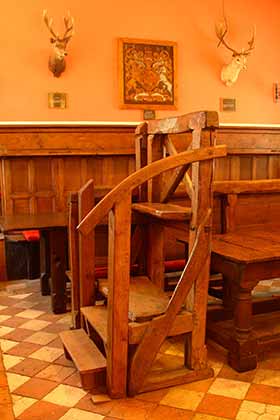Verderers’ Court and Verderers' Hall

The Verderers’ Hall is at the top of Lyndhurst High Street, attached to Queen’s House. It is the home of the ancient Court of Verderers, a body originally constituted to deal with those who offended against Forest Law.
Currently ten in number, the Verderers' modern role is to:
a) protect and administer New Forest commoning practices,
b) conserve the New Forest landscape, wildlife and aesthetic character; and
c) safeguard a viable future for commoning.
The Verderers also have authority to restrict encroachment or trespass on the New Forest, a power that on more than one occasion has helped safeguard the long term character of this age-old landscape.
Of the ten Verderers, the Official Verderer is appointed by the Crown, whilst four others are appointed by, respectively, the Department for Environment, Food and Rural Affairs (DEFRA), the Forestry Commission, the New Forest National Park, and Natural England. The remaining five Verderers are elected by the New Forest commoners.
Five Agisters are employed by the Verderers to deal on a day-to-day basis with the commoners’ stock. They attend all-too-frequent road traffic accidents involving the stock; organise the annual pony round-ups, or drifts as they are more properly known; and ensure that the welfare of the stock is maintained at an acceptable level.
The Verderers’ Court meets monthly, except in August when there is no meeting. Apart from in December, the first part of the proceedings is open to the public.
During each meeting, commoners and others have the opportunity to make 'presentments' during which relevant issues of the day can be raised. The Verderers’ response is given, and an animal traffic accident report provided.
The Verderers’ Hall has a long and proud history. In 1388, a building in which the New Forest courts could meet was constructed within or beside Lyndhurst’s old manor house, the building which later became Queen’s House. The current Verderers’ Hall is believed to occupy the same site as the original, although the building has been considerably affected by alterations to Queen’s House.

Inside the Hall, an ancient, rough-hewn dock is used by those making 'presentments' to the Court, a reminder of the days when breakers of Forest Law were harshly treated.
Nearby can be seen Rufus’s Stirrup, a large iron stirrup that recalls, at least in name, William II, or as he was sometimes known, William Rufus - this is the same Rufus who in August 1100 was killed by an arrow allegedly shot by Sir Walter Tyrrell.
The stirrup is probably, though, of Tudor date, and was used to determine whether dogs were to be cruelly maimed to prevent them chasing deer - dogs small enough to pass through were considered harmless; larger dogs were not, and had their paws badly mutilated.
Hanging on the walls are the mounted heads of deer, reminders of the New Forest’s original role as a royal hunting ground. The story of two displayed fallow deer heads found with antlers hopelessly entangled was recalled by Peter Evening in the 1974 book New Forest Walks. He tells that: ‘These poor beasts died as a result of a fight during the rut of 1905 when their antlers became inextricably entwined. During the contest of strength, the weaker was pushed backwards into a drainage ditch and its adversary following on broke its neck in falling and subsequently smothered the one beneath.’
He also went on to say: ‘A similar tragedy occurred in 1967 when the antlers of two rutting roebucks became entangled. Unable to break free, they both eventually died of exhaustion and starvation.' Their antlers, too, hang in the Verderers’ Hall.
References:
Lyndhurst Historical Society publications: Roy Jackman
Lyndhurst – A Brief History and Guide: Georgina Babey and Peter Roberts
New Forest Walks: Peter Evening
Verderers of the New Forest
More links
Other related links
Search this site

Sadly, 58 animals were killed - 35 ponies, 13 cows, 8 donkeys and 2 sheep, whilst a further 32 were injured - 3 pigs, 9 donkeys, 11 cows and 9 ponies.
(Forty-three accidents occurred in daylight, 15 at twilight and 101 in the dark. Twenty-seven accidents were not reported by the driver involved).
Here's just one horrific example - Three donkeys killed in collision with van at notorious New Forest blackspot (Advertiser and Times)

